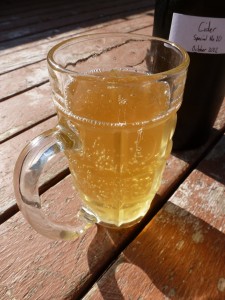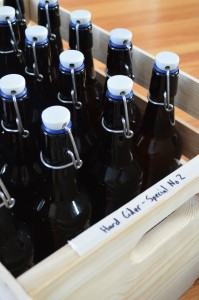 Earlier in the month we pressed our apples into cider. The juice that ran from the press was sweet and tart, with a full, milky mouthfeel, and a subtle siltiness that I think was from the skins and seeds of the fruit. It had a cloudy, oxidated colour and was a pleasing drink in all of its many facets.
Earlier in the month we pressed our apples into cider. The juice that ran from the press was sweet and tart, with a full, milky mouthfeel, and a subtle siltiness that I think was from the skins and seeds of the fruit. It had a cloudy, oxidated colour and was a pleasing drink in all of its many facets.
Fermentation
As with grapes, there is an abundance of natural yeast living on the skins of apples, and when you crush the fruit and mix the skins with the juices, the yeast has easy access to sugar. I’m always surprised by the efficacy and consistency of this natural fermentation. Basically the cider can sit in your basement for a week, and fermentation will begin all on it’s own. For a brief few days, the cider gets even better than when it was first pressed. A yeasty aroma develops, and the resulting alcohol wakes up the palate. The drink becomes slightly effervescent.
Preserving Apple Juice. The natural fermentation described above is inevitable unless you take specific measures to prevent it. If you want to keep your non-alcoholic apple juice for more than a week, you have two methods at your disposal. The first is freezing. The principal advantage of freezing is that it preserves a lot of the fresh aroma of the beverage, as well as wild yeasts. The disadvantage is the moderate energy required to run your freezer for months on end, and frozen liquids tend to take up a good deal of valuable freezer space. The second option for preserving fresh apple juice is canning. The canning process pasteurizes the juice, killing any yeasts and thereby preventing alcoholic fermentation, but it also kills some of the aroma of the drink. You then have a jar of delicious apple juice that can safely sit on your shelf at room temperature, freeing up freezer-space for other necessities like meat. The downside of this preservation method is that it is extremely energy intensive.
Why to Ferment to Hard Cider. So you can see that both methods have their pros and cons. Fermenting the apple juice to hard cider solves all the issues mentioned above. Of course fermentation drastically changes the flavour of the cider, but it actually heightens the aroma and flavours. And the real beauty is that alcohol is a natural antiseptic, so hard cider can be bottled safely without the heat treatment required for fresh juice. The only power I use in my cider-making is operating the crusher.
How to Ferment to Hard Cider. As described above, fermentation happens all on its own. The major draw back to natural fermentation is that it is unpredictable and inconsistent. Every now and again fermentation will stall, and it becomes clear that some other organism has taken hold of the juice. If the cider is racked, the yeast usually re-asserts itself. For a more complete discussion of some of the weird stuff that can happen, see my post on making vinegar. Even if true alcoholic fermentation proceeds, inconsistent and unpleasant aromas often develop.
Pitching commercial yeast will control the fermentation and draw desired aromas from the fruit. There are a few strains of cider yeast. A Riesling yeast called Rudesheimer also works well. I have a friend who uses lambic yeasts.
Cider Styles. On a long enough time line, without preventative measures, all cider will ferment till it is completely dry, that is, void of sugar. If you’d like to have any residual sugar in your cider, the most common method is to treat the cider with sulfite to kill the yeast and arrest the fermentation.
 Bottle-Fermenting.To know when to bottle hard cider you must first decide what style of cider you want to make, namely still or effervescent? If effervescent, do you want light carbonation, like you might find in English ale, or heavy carbonation, like the large bubbles dissolved in Champagne? You control this by bottling when the cider has a certain specific gravity. Specific gravity is a way to approximate the amount of residual sugar in the cider, and the more sugar that is left at bottling, the more effervescent the drink will become.
Bottle-Fermenting.To know when to bottle hard cider you must first decide what style of cider you want to make, namely still or effervescent? If effervescent, do you want light carbonation, like you might find in English ale, or heavy carbonation, like the large bubbles dissolved in Champagne? You control this by bottling when the cider has a certain specific gravity. Specific gravity is a way to approximate the amount of residual sugar in the cider, and the more sugar that is left at bottling, the more effervescent the drink will become.
- At a specific gravity of 1.000 or lower the cider will be still, that is, not effervescent. Still cider can be bottled in almost anything, including wine bottles with a cork.
- By bottling around 1.003 you will end up with cider that has the mild effervescent of beer. This style of cider should be bottled in a beer bottle with a crown cap or swing cap. (One fall I drank only Hacker-Pschorr and Muskoka Spring Oddity so that I could collect the swing cap bottles…)
- At 1.008 the cider will be very sparkling, like Champagne. Lots of pressure builds in the bottle, so this style of cider must be bottled in a heavy, Champagne bottle. The cork must be caged to keep it in place. Some types of Prosecco come in heavy bottles with swing caps.
Dorky sidenote. I’ve developed a labelling shorthand for my bottled cider to give an idea of what the carbonation level is. A label reading only “Cider” is still. Sparkling cider is labelled “Cider – Special No. X” where X is the last two significant digits of the gravity reading before bottling. So, Special No. 10 is very bubbly, while Special No. 3 is only faintly effervescent.
Most sources say that bottle fermentation takes two weeks at minimum. I’ve cracked some bottles at that point and found them flat, so I try not to touch them for at least four. But if you can wait even longer, you will be rewarded…
Aging Cider. Immediately after fermentation, sometimes my cider is good but not great. The acidity is a little harsh, and occasionally there are some funky odours, perhaps sulfur, or solvents like nail-polish remover. Some cider can benefit hugely from a few months aging.
Effects of Aging Cider. Last year on St. Patrick’s Day I pulled one of the few remaining litres of still cider out of the cellar to thin out my corned beef drippings. I don’t think I had tasted it since Christmas. The cider had gone through a remarkable transformation. Obviously it was still dry, but nowhere near as abrasively tart as it had been in December. The acidity had mellowed markedly. All in all it was actually quite well balanced. And somehow the nose has lost the harsh odours.
Malolactic Fermentation in Cider? My best guess as to why the cider changes so much is a process called malolactic fermentation, a bacterial fermentation that converts malic acid to lactic acid. It occurs naturally in some classic wines, and is now induced by vintners for certain styles, notably oaked Chardonnay. I don’t think that MLF changes the absolute pH of the wine, but lactic acid is much softer and more palatable than malic acid, so the perceived acidity decreases. The two main acids in grapes are tartaric and malic acids. Apple juice contains mostly malic acid, so it’s possible that if MLF were to take hold in cider, it would greatly affect the tartness of the drink. My sources on winemaking say that MLF bacteria naturally inhabit the wood of the barrels. Whether or not MLF could start spontaneously in apple cider stored in plastic and glass, I’m not sure, but it’s the best guess I have to explain the dramatic change that apple cider goes through over six months storage.